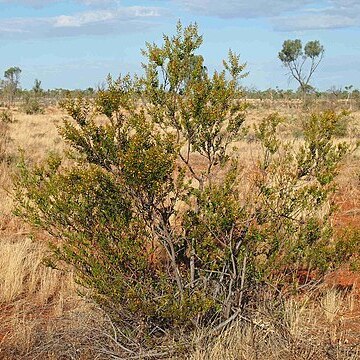Shrub 1–4 m high, glabrous and resinous. Branchlets often sparsely tuberculate. Phyllodes oblanceolate, (4–) 5–8.5 cm long, (9–) 10–25 (–28) mm wide, l: w = 3–7 (–11), obtuse, mucronulate, thickly coriaceous, smooth or asperulate by small tubercles on nerves, dark green but soon aging grey-green or an attractive blue-grey, with resin sometimes drying white (especially over veins); prominent longitudinal veins 2 or 3, with secondary veins forming a coarse, open reticulum; basal gland prominent, elongate, 1–3 mm long, with an obscure smaller gland at base of the minute apical point. Inflorescences simple, 1–3 per axil; peduncles 10–25 (–50) mm long, ebracteate at base; heads globular or obloid, 9–13 mm diam. when dry, densely 40–60-flowered, golden. Flowers 5-merous; sepals united almost to their apices. Pods stipitate, narrowly oblong, flat, raised over seeds alternately on each side, to 9 cm long, 1–1.6 cm wide, firmly chartaceous, often ±vernicose. Seeds transverse, c. 4 mm long, arillate.
More
An evergreen shrub. It grows to 1-4 m high and spreads to 1-4 m across. The stem is slender and branching. The small branches are ribbed and sticky. The leaves (phyllodes) are wedge shaped and oblong. They are 2-7.5 cm long and taper towards the base. They are 0.5 to 1.8 cm wide. They have a network of veins. Newer growth is green but older leaves look grey green due to the dry sticky material. This is helpful in recognising this plant. The flowers are yellow balls. They occur 1 or 2 together and in large numbers in the angles of leaves. They are sticky. The pods are light brown. They are 5-10 cm long by 1-1.5 cm wide and are flat. They have a papery feel and a varnished appearance. The small brown seeds have a soft coat.
Acacia dictyophleba is used extensively in mine site rehabilitation programs in the Pilbara, Western Australia. It is an attractive shrub with horticultural potential on account of its large golden flower-heads and often blue-grey foliage that is coated with a white bloom at certain times of the year.
More
The seed is eaten. The seeds are ground like flour then eaten. The seeds are very nutritious being 26 % protein. Grubs are found in the roots.

